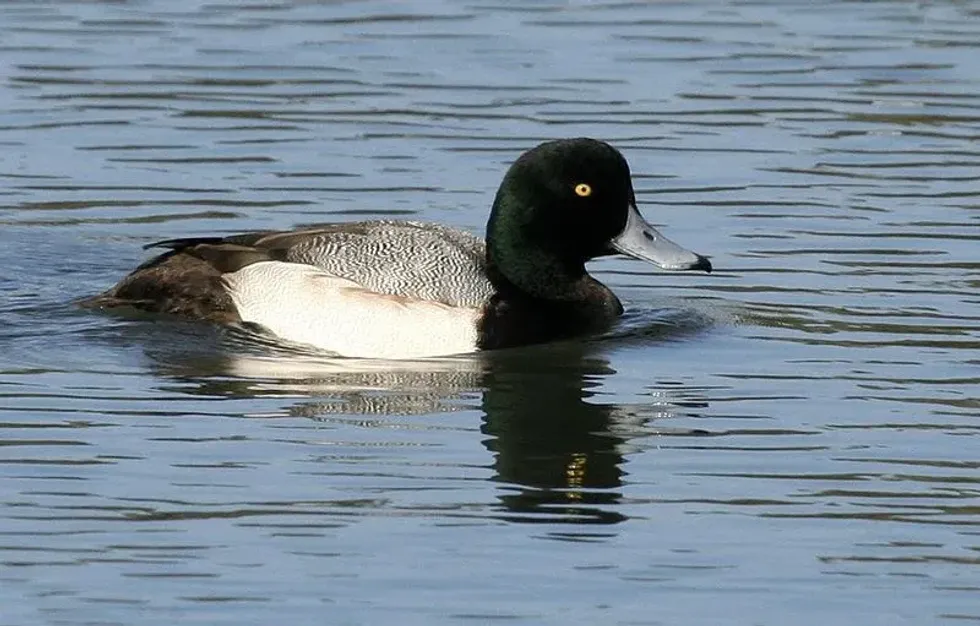Have you ever come across a name called greater scaup duck? Of course, you have. Greater scaup is a medium-sized diving duck in the bird family.
These birds are among the migratory species that are different in appearance with some special features. The greater scaup appears quite similar to the lesser scaup with the only visible difference being the slightly rounded head shape. As a result, both the greater and lesser scaup are counted together while determining the total population of the species.
Do you wish to learn more about them? Here are some fun, engaging, and interesting facts on greater scaup (Aythya marila). Afterward, do check our other articles on the ringed seal and the Asiatic black bear.
Greater Scaup Interesting Facts
What type of animal is a greater scaup?
Greater scaup is a medium-sized duck that belongs to the Anatidae family, like the lesser scaup. It is almost similar in appearance to the lesser scaup. It is a diving duck with a rounded head. Like lesser scaups, these birds build their nests near water and are typically seen around rivers, lakes, coastal waters, and salt bays.
What class of animal does a greater scaup belong to?
Greater scaup is a diving duck that belongs to the Anseriformes order in the Anatidae family. Its scientific name is Aythya marila. Females are brown in color, whereas, males are brown and gray in color with a blackish head. During winters, these ducks can be located in lakes around coastal regions.
How many greater scaups are there in the world?
Greater scaups are significant in number but there is a slight decline in their population. The global estimate of the number of greater scaup is around 780,000. The cause of the decline in their population can be pollution.
Where does a greater scaup live?
Greater scaups are migratory species usually found in northern Europe and Asia. These birds are found in Siberia, Alaska, and northern Canada during the summer months where the breeding takes place and it migrates from there to Japan, North America, and Europe in winters.
What is a greater scaup's habitat?
Greater scaups prefer to live in rivers, salt bays, lakes, and estuaries. During the summer these birds are usually near the northern limits of boreal forests to the tundra and migrate to coastal bays and lakes in winters.
Who do greater scaups live with?
Greater scaups are migratory birds and migrate in flocks. These birds prefer to live in groups.
How long does a greater scaup live?
Greater scaups may live around 10- 12 years in the wild but can live up to 22 years in total.
How do they reproduce?
Drakes display complex courtship and form monogamous male and female pairs. A female greater scaup lays six to nine eggs and builds the nest usually near the water shore. Drakes abandon the female greater scaups after the eggs are laid. It is incubated for 24-28 days by females. Chicks are capable of feeding themselves after 40-45 days.
What is their conservation status?
Greater scaups are under the Least Concern status in terms of their conservation. But the population of greater scaup and lesser scaup is steadily decreasing.
It can be due to pollution, loss of habitat, and changing breeding habits. The female survival rate of greater and lesser scaup has become comparatively lower which is another reason for the decline. As of now, there are no restrictions on the killing of greater scaup in place.
Greater Scaup Fun Facts
What do greater scaups look like?

Greater scaup is a medium-sized diving duck that belongs to the Anatidae family. Both the male and female are different in appearance. The head of the male is more round which is dark and has a green sheen.
It has a black breast, tail, and also a white underside. The drake is larger than the female greater scaups.
Its belly is white in color. The body of the female is brown in color with a white band oval-shaped patches are seen at the bill’s base. Their head color is different from the drake's.
How cute are they?
Greater scaups, like lesser scaups, are medium-sized birds that have a round head and yellow eyes. These birds are cute in appearance.
How do they communicate?
Birds communicate through songs and calls. Greater scaups are usually silent but make a soft sound during courtship. A faint 'wee-o' call is made by them. Females are louder and more vocal than males.
How big is a greater scaup?
Greater scaup is a medium-sized diving duck and has a length of 15-22 in (38-56 cm) and a wingspan range of 28-33 in (71-84 cm).
How fast can a greater scaup move?
Greater scaup in flight looks absolutely majestic as these ducks can move very fast because of their quick greater scaup wing beats. Greater scaup flying speed has been measured at around 75 mph (121 kph).
How much does a greater scaup weigh?
On an average scale, a greater scaup range of weight is around 1.6-2.9 lb (0.7-1.3 kg) with a male greater scaup being slightly heavier than the female greater scaup. The lesser scaup weighs 1.1-2.4 lb (0.4-1.08 kg) and the ring-necked duck weighs 17.3-32.1 oz (490-910 g).
What are the male and female names of the species?
A male greater scaup is called a drake and a female is known as a hen.
What would you call a baby greater scaup?
A greater scaup baby is called a duckling or chick.
What do they eat?
Greater scaup’s diet includes mollusks, aquatic plants, aquatic insects. These bird species have different food habits in summer and winter. During winters, this bird species feeds on oysters, mussels, and snails whereas in summer their food comprises grass, pondweeds, and insects. Their main predators include owls, skunks, raccoons, and humans.
Are they dangerous?
Greater scaups are not dangerous and do not pose any threat to others.
Would they make a good pet?
The greater scaup is a medium-sized diving duck that lives in the wild. So these bird species are not suitable for making a pet.
Did you know...
Greater scaups are called bluebills in North America, whereas, it is called scaup in Europe. Scaups are one of the most popular game birds.
The meat of scaup is fit to eat for humans but the key is to eat it fresh.
Where does greater scaup migrate?
Greater scaups are migratory species usually found in northern Europe and Asia. These bird species are found in Siberia, Alaska, and northern Canada during the summer months where the breeding takes place and it migrates from there to Japan, North America, and Europe in winters.
How to tell the difference between, ring-necked duck, greater scaup, and lesser scaup?
Among the three, greater scaups are larger than lesser scaups which are small in size, and ring-necked ducks which are intermediate in size. The head is narrow for lesser scaup, broad and round for greater scaup, and peak at back for a ring-necked duck.
Here at Kidadl, we have carefully created lots of interesting family-friendly animal facts for everyone to discover! Learn more about some other mammals from our grey seal facts and slender loris facts pages.
You can even occupy yourself at home by coloring in one of our greater scaup coloring pages.










